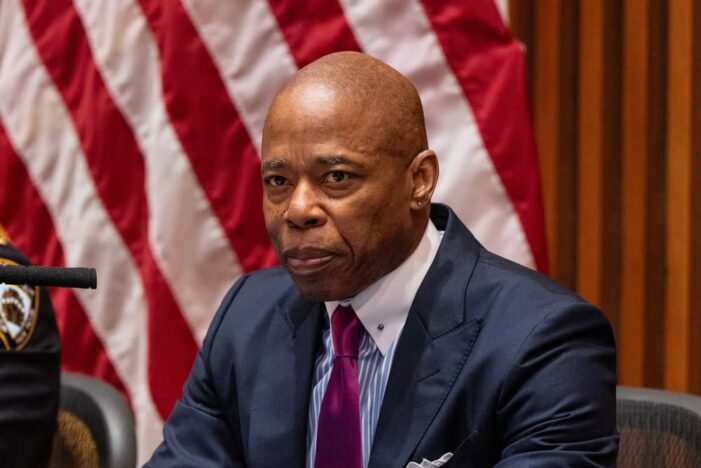Editorial credit: lev radin / Shutterstock.com
By Ethan Geringer-Sameth | City & State New York
Seventy years after Brown v. Board of Education, New York City classrooms are among the most segregated in the nation. Now, a new report from New York University claims Mayor Eric Adams and Schools Chancellor David Banks have abandoned the cause of integration and, in some cases, even moved the city backward.
The report, published by the NYU Metro Center on Tuesday and shared exclusively with City & State, analyzes the city’s progress toward a set of recommendations put in place in 2019 during the de Blasio administration aimed at the heart of exclusionary school admissions policies. The authors of the study, who helped craft those recommendations, accuse Adams and Banks of “a clear lack of central leadership and intention” around desegregation in New York City, where most Black and Latino students currently attend heavily segregated schools.
“The train has left the station and the work continues on. But what we really need to move things forward would be having city leadership also on board,” said Nyah Berg, executive director of New York Appleseed and a co-author of the report, in an interview with City & State.
In 2017, after years of headlines highlighting New York City’s abysmal record on integration, Mayor Bill de Blasio empaneled an advisory group to study the issue and recommend actionable alternatives. The School Diversity Advisory Group released two sets of recommendations in 2019. The first, dealing with the type of education programs that would foster a thriving integrated school setting, was largely backed by de Blasio and his Schools Chancellor Richard Carranza. But the de Blasio administration largely ignored the second set of recommendations, which included changes to public school admissions policies that would actually shift student demographics. De Blasio could not be reached for comment.
The NYU Metro Center examined the city’s work on each of the 100 recommendations that the advisory group made. In most cases, the Adams administration has ignored or outright rejected them, according to the NYU report, which was co-authored by former leaders of the advisory group. Even the first set of advisory group recommendations – the ones that the de Blasio administration largely embraced – is now in question, the report found.
The report points to the Adams Administration’s rejection of a number of recommendations aimed at removing barriers to school admissions, including a moratorium on new Gifted & Talented programs, the elimination of academic tracking in elementary schools and screening measures in middle schools, a pause on the creation of new high schools that use screening; the prioritization of high performing high schools for inclusionary admissions practices and increased funding for district-level admissions planning.
Instead of pursuing those recommendations, the Adams administration has gone in the opposite direction, increasing the number of Gifted & Talented programs in elementary schools and reinstating screens in some middle schools. The report found that 78 middle school programs – including 23 programs in Community School District 20 in southwest Brooklyn – have opted to bring back screening measures. And in May, Banks hinted at restoring a controversial geographic preference for some Manhattan high schools, a measure de Blasio did away with in 2020.
Before the pandemic, the city and state spent roughly $1 million each on diversity planning processes, but that funding ceased in 2020 and hasn’t been restored. Matt Gonzales, director of the Education Justice Research and Organizing Collaborative at NYU Metro Center and a co-author of the report, said that legislation approved in 2019 requires the city to conduct district-level diversity working groups, but that program has never been funded.
According to Gonzales, the NYU Metro Center had until recently worked with the Department of Education’s Office of Equity & Access to develop culturally-responsive curricula – which the advisory group had recommended — but that effort has fallen on hard times following recent leadership shuffles and budget cuts.
“There are people (at the Department of Education) that we at the Metro Center work with right now who are currently just in flux about where their bodies of work are going to exist,” he said. “The shifting of priorities, which obviously happens, but now we’re two years into the administration and they’re still trying to figure out what the priorities are, that has created a lot of turmoil.”
The Office of Equity & Access is no longer listed on the Department of Education’s website and its account on X has not posted since January 2023. Its last post was about working with the NYU Metro Center to train educators in culturally-tailored learning models.
Banks and Adams – two Black politicians who are products of New York City public schools – have made clear that schools integration is not their top educational priority. “It’s a complicated issue,” Banks said in a recent interview with Chalkbeat. “For me, I have not spent a lot of time on it because I recognize that as chancellor, you can’t do everything…I’m trying to make sure that, wherever you happen to be, your district, your neighborhood has all the great stuff that anybody else has.”
Department of Education Press Secretary Nathaniel Styer defended the administration’s approach. “Our administration listens to parents and responds to what they want for their children, and we’ve heard repeatedly that families want access to high-quality options in their neighborhood. NYC Public Schools is focused on ensuring no matter where a student lives they have access to high-quality educational options through creating more accelerated schools, placing more Gifted & Talented programs in neighborhoods that previously did not have them, and supporting community-driven integration efforts,” he wrote in an email to City & State.
Styer made clear that the Department of Education believes that racial segregation in schools is a consequence of historic and current housing trends that fall outside the department’s purview. “Segregation did not begin in our schools, and it will not end in our schools, but we can ensure that every NYC student has access and opportunity on par with the best schools in our nation,” he wrote.
Correction: This article has been updated to clarify that the NYU Metro Center report found that 78 middle school programs, not superintendents, brought back screening measures. It has also been updated with additional context regarding the Department of Education’s position on school desegregation policies.


